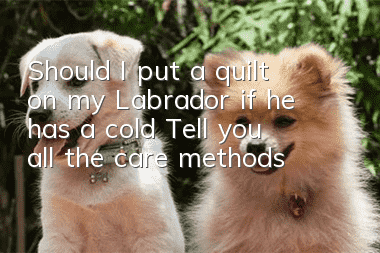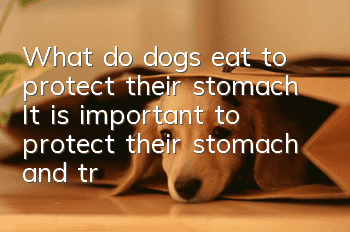Should I put a quilt on my Labrador if he has a cold? Tell you all the care methods!

How to care for a Labrador cold?
1. Pay attention to appropriately clothing the Labrador to keep warm, and keep the breeding environment dry and clean.2. The Labrador dog’s nest can be padded with thick mats to avoid catching cold.
3. Increase outdoor exercise to enhance the physical fitness and immunity of Labrador dogs.
4. Appropriate vaccinations against colds and infectious diseases can be obtained to enhance resistance.
Causes of colds in Labradors:
1. The weather suddenly becomes cold.
2. The temperature difference between day and night changes greatly.
3. Failure to blow or dry the hair in time after bathing.
4. Labrador dogs are exposed to rain or wind after sweating a lot.
Symptoms of colds in Labrador dogs:
1. Not in good spirits, wilting, and likes to lie down;2. Watery nose;
3. Sneezing and coughing;
4. Congestion of the conjunctiva, tearing, and loss of appetite;
5. Increased body temperature, usually 39~40°C;
Labrador Retriever Cold Treatment methods:
Labrador dogs’ cold symptoms are similar to those of people. If your dog is an adult, you can give it some cold medicine that people take, and give it some more water. If it is a puppy, just give it half the normal amount of medicine for a human. Dog colds must be treated quickly. Because when a puppy catches a cold, his body's immunity is very poor and he will be easily infected with other diseases.Diseases that cause colds in Labrador dogs:
1. VomitingLabrador dogs are prone to vomiting. They often vomit to protect themselves and reduce damage to their gastrointestinal tract. If you vomit occasionally and there are no other abnormalities before and after vomiting, don't worry. It's even more harmless if you eat it as soon as you spit it out. If the frequency of vomiting is high, vomiting, drinking water, vomiting, and drinking water after vomiting, attention should be paid to timely treatment of the primary disease. Vomiting should generally be fasted for 24 hours and given small amounts of drinking water several times a day.
2. DiarrheaSick Labrador dogs with diarrhea should fast for at least 24 hours and be given sufficient clean drinking water, with 1% salt added. It is best to give oral rehydration salts if possible. After fasting, feed less irritating liquid foods, such as rice soup, juice, vegetables, etc., eat small meals frequently, and gradually transition to a normal diet. Labrador, Labrador kennel, Cantonese Labrador kennel, hunting dog, guide dog, Cantonese kennel, Cantonese Labrador, Labrador retriever, Hunter Labrador Kennel;
3. Loss of appetite
If the Labrador does not vomit, prepare palatable and nutritious liquid food, and use auxiliary tools such as straws, spoons or syringes to forcefully pour it from the corner of the mouth, or put the thin food into it. The meat is made into pellets and forced to be swallowed by the dog to stimulate appetite. When forcibly pouring food, pay attention to the safety of people and dogs to prevent biting or accidental swallowing into the dog's trachea, which may cause breathing difficulties or death;
4. Nasal secretions and dry nose
Labbing When there is not much secretion in the dog's nasal cavity, absorbent cotton or gauze can be used to wipe it; when there is a lot of secretion and it fills the nostrils, wipe it with cotton swabs in time to keep the nostrils breathing smoothly. When your nose is dry for a long time, wipe it with glycerin to prevent cracking.
5. Eye secretionsFor Labrador dogs, soak absorbent cotton with 2% boric acid water and wipe clean before using eye drops. When purulent eye discharge occurs, there may be systemic disease and should be treated in time. Labrador, Labrador kennel, Cantonese Labrador kennel, hunting dog, guide dog, Cantonese kennel, Cantonese Labrador, Labrador retriever, Hunter Labrador Kennel;
6. Fever
During the low temperature season, Labrador dogs will feel cold and shiver. The kennel should have thick bedding and pay attention to heat preservation. The kennel should be airtight to prevent cold wind from blowing in. During high temperature seasons, the room temperature should be lowered, and a variety of whole-body cooling measures (alcohol body rubs, cold water baths, etc.) should be taken to lower the dog's body temperature. When the body temperature drops to 39.4°C, this cooling measure should be stopped.
7. Cough
Try to keep the Labrador as quiet as possible, reduce environmental stimulation, prohibit exercise, reduce external pressure on the neck, relax the neck, and inhale more moist air. When severe cough causes difficulty in breathing, oxygen should be given and symptomatic treatment should be given in time. Labrador kennels, Labrador kennels, Cantonese Labrador kennels, hunting dogs, guide dogs, Cantonese kennels, Cantonese Labrador kennels, Labrador kennels, Hunters Bradhound kennel.
- How to tell if your dog is fat? Is your dog overweight?
- Will your dog catch a cold if you blow the air conditioner? What should you do if your dog catches a cold if you blow the air conditioner?
- The dog's mouth bites and shakes. Why does the dog's mouth occasionally shake and bite?
- How to cut a dog's hair? Do you know how to cut a dog's hair correctly?
- Can dogs eat raw eggs? Why can’t dogs eat egg whites?
- Common Dog Problems in Summer How to Deal with Different Dog Problems
- How to keep dogs away from skin diseases. If you do this, will you see if your dog will still be infected with skin diseases?
- What causes anorexia in dogs? Dogs will become anorexic due to lack of exercise. Hounds run at least 5KM every day.
- Can dogs eat liver? What should you pay attention to when giving liver to your dog?
- Can canine herpes virus be transmitted to humans? Owners should not be too nervous



